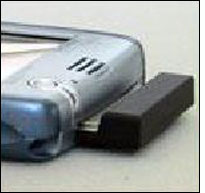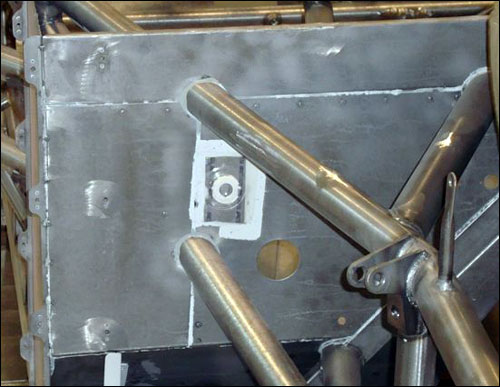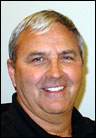May 18, 2010The National Association for Stock Car Auto Racing (NASCAR) has been employing radio frequency identification to track the chassis on each car that races in its Sprint Cup Series, as well as special fuel tanks known as fuel cells, thereby ensuring that chassis are not replaced or tampered with prior to a race, and that each team has an official NASCAR fuel cell with exactly the same capacity—17 gallons. In so doing, the organization can better ensure that each racing team complies with its regulations, and help ensure the safety of the cars and their drivers, since an altered chassis or fuel cell could offer a racer an unfair advantage over other drivers, while also making the car more vulnerable in an accident.
After three years of using the system to track chassis and fuel cells, the association is now looking into further opportunities to utilize the technology to improve safety and efficiency, as well as make the racing events fair, says Jerry Kaproth, NASCAR's safety coordinator.
The racing association first sought an RFID-based solution in 2006, when it began developing its Car of Tomorrow (COT), a vehicle specifically styled for its Sprint Cup Series. Larger and boxier than its predecessors, the car is designed to be safer and less costly to maintain. NASCAR wanted to ensure, however, that the vehicles were not changed in any way to improve performance, such as altering the chassis on which they are built. A lighter chassis, for example, could make a car potentially faster, but would also make it more dangerous to drive, since the chassis would not be as sturdy. In addition, because the chassis could be altered to re-proportion the weight in such a way as to give a car an advantage, NASCAR needed to track not just the overall chassis, but also its individual components. Therefore, NASCAR attaches 10 separate tags to each vehicle, on a variety of key chassis sections.
For inventory purposes, the association also wanted to track the wings that teams attached to the backs of race cars, to improve speed. By applying an RFID tag to each wing, NASCAR would know to whom it issued the wings, and when it received them back following the race.

The RFID project began with research and development by NASCAR into its COT. The association selected Franwell as the systems integrator and software provider for the RFID solution. The Franwell/NASCAR team proceeded to test tags and interrogators, choosing the optimal combination, as well as the best location to place the tags. There were several challenges, NASCAR reports. Although the chassis tags needed to be adhered directly to metal, the organization had also wanted to embed them directly into the carbon-fiber composite material of its wings. Finding a tag that would be readable in both of these applications meant testing a variety of options before the group settled on low-frequency (LF) 125 kHz passive RFID tags from HID Global, that were found to be readable whether attached to metal or embedded in carbon-fiber composite.
To ensure that the tags could not be peeled off the chassis, two security features were included. The tag itself was designed to be tamper-resistant, so that if someone attempted to peel it off the chassis, its antenna would break away from the chip, thereby rendering the tag inoperable. In addition, NASCAR placed a hologram label over each tag, after it was attached to the chassis, that could not be removed without being destroyed.
To receive NASCAR certification for a car, a race team must first have the vehicle's chassis inspected by employees at NASCAR's Research and Development Center, located in North Carolina. Once it is approved, the staff places 10 RFID tags on the chassis, each in a different location, to ensure that the chassis is not altered or replaced. Workers then read each tag using a Dell Axim x51v PDA with an RFID interrogator plugged into the device's CompactFlash slot, and input the identity of the team that owns the chassis, to be linked to all 10 RFID tag ID numbers in software provided by Franwell.
As wings were issued at the race itself, their RFID tags were read by NASCAR's staff, and the driving team's identities were input and linked to that tag's unique ID number. The association's employees then inspected the vehicles, using the handheld device to capture the unique ID numbers of all 10 tags on the chassis, to confirm it had not been tampered with.
At the end of the race, the wings were returned and read once more to verify that the teams had returned them. (In March 2010, the wings were replaced by aluminum spoilers that are neither tagged nor tracked.)
Once the tags are read, transaction data is stored on the handheld. When the device comes within in range of a Wi-Fi Internet access point, it transmits the information to the SQL server database at NASCAR's data center. The Franwell software also enables the association to generate reports from the data showing, for instance, a breakdown of which certified items were verified at a particular race.
Because the installation was a success, NASCAR reports, it has been tagging fuel cells since February 2007. Each fuel cell contains a rubber bladder, foam and other structures to keep gasoline from leaking out in the event of an accident or other vehicular damage, and possibly igniting a fire. The tag attached to each fuel cell's metal exterior is read at the time it is issued to a team, and the team's identity is stored with that fuel cell's RFID tag ID number. The tags are again read at the initial inspection, before the first race, at which time the Franwell system is used to verify that the team has installed a certified fuel cell in the car. Finally, they are read one last time once the fuel cell is returned.
The system has been very successful, Kaproth says. The COT vehicles with tagged chassis ran in 16 races in 2007, as well as in all 38 events of the 2008 and 2009 Sprint Cup Series. NASCAR, he indicates, is now exploring other ways in which it can use RFID to improve the race processes, though he declines to identify any specific plans at this time. Franwell intends to soon provide the association with ultrahigh-frequency (UHF) EPC Gen 2 tags, to replace the LF tags it currently utilizes, according to Terri Crawford, Franwell's VP and COO. The LF tags were chosen, in large part, because of their ability to be read when embedded in the wings—but since NASCAR no long uses the wings, she says, a UHF tag is a better choice, due to its longer read range.



